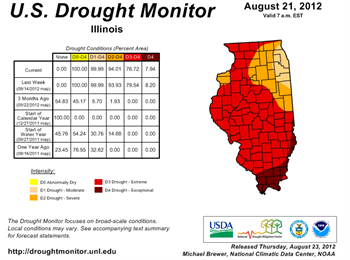
Ken Schneider/Flickr CC
We’re in a drought, a very serious one. The worst one since the 1950s. Even with the cool down in temperatures and a few recent rainy days, it’s not enough to make up for the damage already done by record-setting high temperatures and the lack of precipitation we’ve had this summer.
The U.S. Drought Monitor has classified drought for the entire heartland, which they do using five categories from D0-D4. The first level, D0, is considered abnormally dry, more like pre-drought conditions. The rest of the categories indicate increasing severity and corresponding agricultural losses and water shortages, with D1 called moderate drought, D2 severe, D3 extreme, and D4 exceptional. Circle of Blue recently went behind the scenes to find out more about the science and art of making weekly drought determinations.

U.S. Drought Monitor
Since May, the drought has become increasingly severe in our region. While the City of Chicago is in the lowest level, or “moderate,” drought, much of the rest of northeastern Illinois is in severe drought, and almost all of Indiana, downstate Illinois, and southeastern Wisconsin are in extreme drought, with small portions in exceptional drought. A recent report indicated that in Illinois, there has been an increase in the number of very hot days in the summer over the last 63 years, a drop in the number of cool, dry days, and rising temperatures on summer nights. Experts believe the drought will continue, and worse yet, this extreme weather is becoming the new normal.
The implications of the drought reach far beyond this summer’s heat waves. Some communities, particularly those on private wells, have seen their spigots run dry. Barge traffic on the Mississippi River has been reduced to one lane, severely impacting local economies. Soil, and subsequently vegetation, have been the hardest hit, from trees—the Chicago Park District and Friends of the Parks are asking residents to help water trees—to crops. All of Illinois’ topsoil has been classified as short or very short of moisture and 95 percent of pasture and range land in Illinois has been declared poor or very poor. International corn and other crop prices are soaring. It takes 155 gallons of water to produce one pound of wheat and seven pounds of feed to produce one pound of beef, so livestock and other animal production also has been affected. Quotas for ethanol production mean some of what little corn is available gets diverted to make fuel. And in our own backyards, communities across the Midwest from Lake Forest, Ill., to most of Indiana are running low on water and instituting emergency lawn watering bans.

Circle of Blue
That said, the drought has resulted in good outcomes, as well. There are fewer tornados, the Gulf of Mexico’s “dead zone” is smaller due to lower nutrient output, oil and gas companies are instituting more water conservation efforts, more people indicate they believe in climate change, experts are encouraging crop diversity, and farmers are making use of newer water conservation technology.
So what are we doing about the drought? At the state level, Illinois has a drought preparedness and response plan and has formed a drought task force, offering data, water conservation recommendations, and financial assistance throughout the state. The Illinois State Water Survey continues to issue information on the drought. Communities across the region are instituting stronger lawn watering ordinances and encouraging property owners to manage their lawns more responsibly.
But it’s not enough just to react to the drought. In a New York Times op-ed last week, water policy expert Charles Fishman urged us to take advantage of the crisis and use the drought to push for better, more efficient water policies and technologies. MPC is working actively on several strategies Fishman cited that can spur advances in water efficiency, including:
Efficient use of water resources, planning for changing conditions, and making smart decisions for our communities are necessary activities to survive current and prevent future emergencies. As Fishman says, “Drought can lead to paralysis and pessimism — or it can inspire us to fundamentally change how we use water.” MPC has been working on these issues for years, and there’s no time like the present drought to welcome new partners, from policymakers to public works officials to homeowners, to join us.